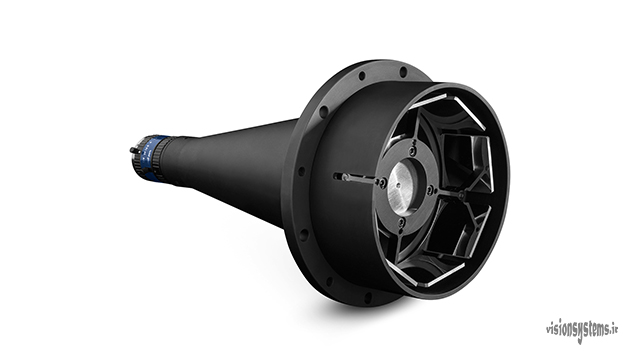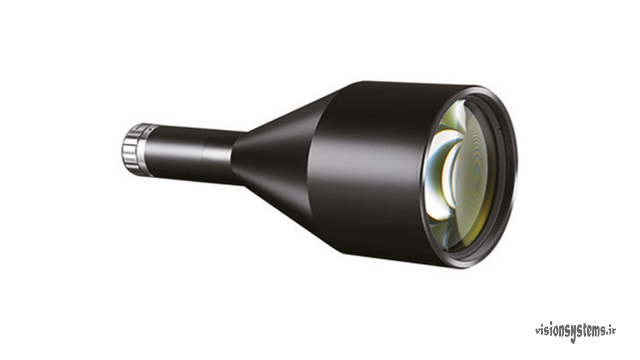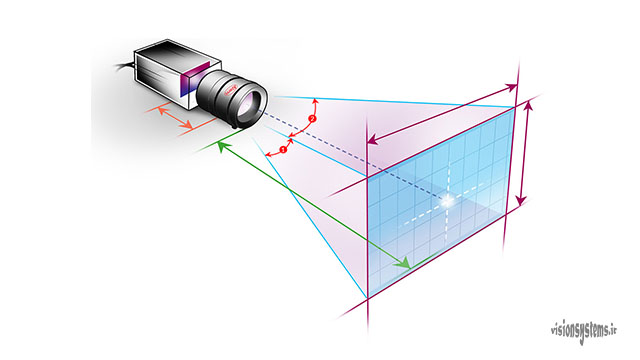When designing a machine vision system, it is essential to carefully choose its components, such as cameras, lenses, lights, and more. For each component, including the camera, factors like resolution, shutter type, frame rate, and others need to be analyzed. One critical consideration when selecting a lens is the working distance.
What Is Working Distance in Industrial Lenses?
The working distance, also known as the distance from the lens to the object, is a crucial factor in industrial lenses. It is measured from the front of the lens. The working distance is illustrated in the figure below, considering a rectangular object with length (V) and width (H).
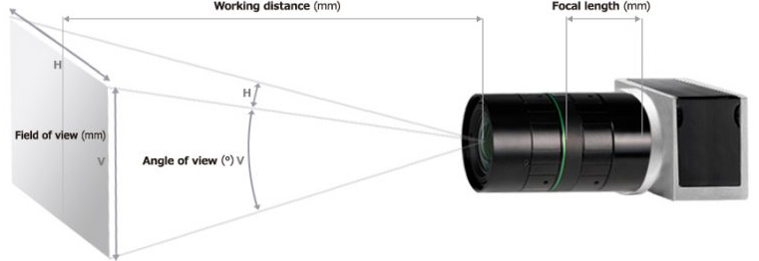
Minimum Working Distance of an Industrial Lens
Industrial lenses have a parameter known as the minimum working distance, which represents the minimum distance you can approach an object. When choosing an industrial lens, ensure that the required working distance is greater than its minimum working distance.
The image below shows a lens with a focal length of 12mm, manufactured by Basler. The minimum working distance is denoted by the parameter “Min Working Distance,” and, in this case, it is 100 millimeters. Therefore, this lens can be used at a distance greater than 100 millimeters.
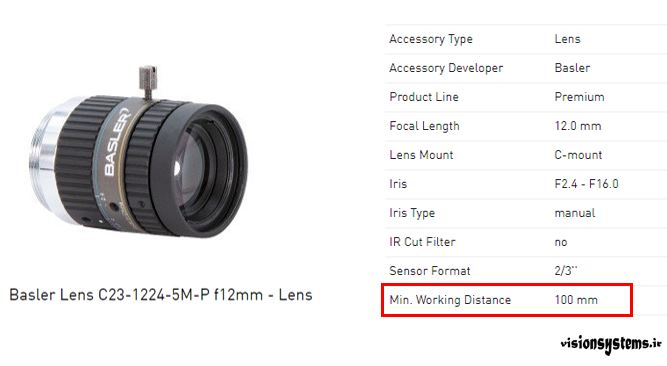
Another example is an Evetar lens, where the minimum working distance is also 100 millimeters.
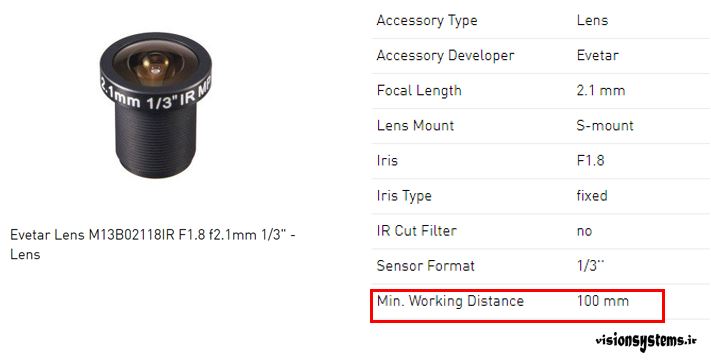
Working Distance Constraint
During the design of a machine vision system, besides the minimum working distance, it’s essential to consider the working distance constraint, which is the maximum distance at which equipment can be installed. This constraint is crucial for lens selection, considering mechanical limitations for equipment installation.
For instance, in a production line where you need to inspect the print quality on products, mechanical constraints may limit you to a maximum distance of 300 millimeters from the object (lens-to-object distance). In this case, choose a lens with a minimum working distance less than 300 millimeters.
Optimal Working Distance
Sometimes, due to space constraints, you might want to reduce the working distance, but this can lead to lens complexity, increased lens cost, and decreased system performance. As a general rule, it’s better for the working distance to be 2 to 4 times the field of view. For example, if you want to view a rectangle with a width of 20 centimeters and a length of 15 centimeters, it’s advisable for the working distance to be between 40 to 80 centimeters.
Using Extension Tubes to Reduce Minimum Working Distance
In cases where you want to reduce the minimum working distance:
- You have a lens with an unsuitable minimum working distance, and you want to use the same lens for your project.
- Mechanical constraints force you to get close to the lens, but the minimum working distance does not allow it.
- Choosing a lens with the required minimum focal distance becomes too expensive. In this case, you prefer to reduce costs by purchasing a lens with a greater minimum focal distance.
To decrease the minimum working distance, you can use extension tubes, also known as calculating close-up rings. These tubes are placed between the camera and the lens, reducing the working distance. Depending on your needs, extension tubes of different sizes can be used. However, keep in mind that using extension tubes has some negative effects, such as increased lens distortion and reduced resolution.
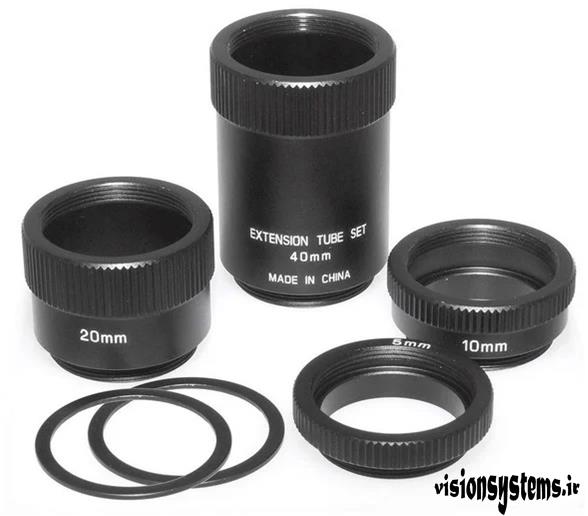
Using extension tubes results in:
- Increased lens magnification.
- Decreased working distance.
- Reduced lens resolution.
- Increased lens distortion.
Effects 3 and 4 are the negative aspects of using extension tubes; therefore, their use is not recommended in some cases.
Calculating Lens Working Distance in Basler Cameras
For analyzing and designing vision systems, it’s essential to calculate the working distance. In Basler cameras, you can use a tool available on the Basler website. To do this, click here to access the tool, then follow the steps below.
First, select the camera model and type. Then enter the lens focal length and the width you want to observe in millimeters. The working distance required for your setup will be displayed automatically.
For example, in the image below, after selecting the camera model and type, a focal length of 12mm, and an image width (larger side in the image) of 150mm, the calculated working distance is 381mm.
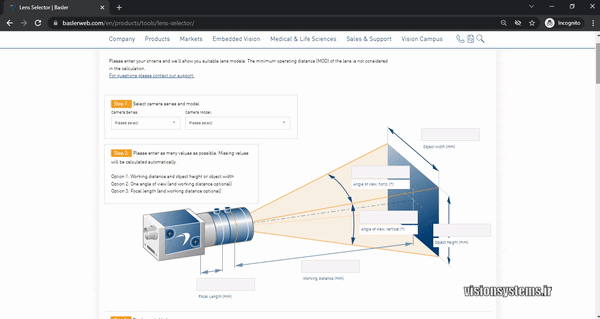
You can use the tool in various ways, selecting two out of three parameters, “Lens Focal Length,” “Working Distance,” and “Image Width,” to automatically calculate the third parameter.
Summary
- Consider whether there are mechanical constraints on the working distance during the design of a machine vision system.
- Calculate the required working distance using the tools mentioned in this article or similar tools.
- When selecting a lens, pay attention to the minimum working distance.
- Ensure that the minimum working distance of your lens is suitable, so you don’t need to use extension tubes.
Keep in mind that when using extension tubes, you need to calculate the required length. If you need assistance in this regard, you can consult our team.





